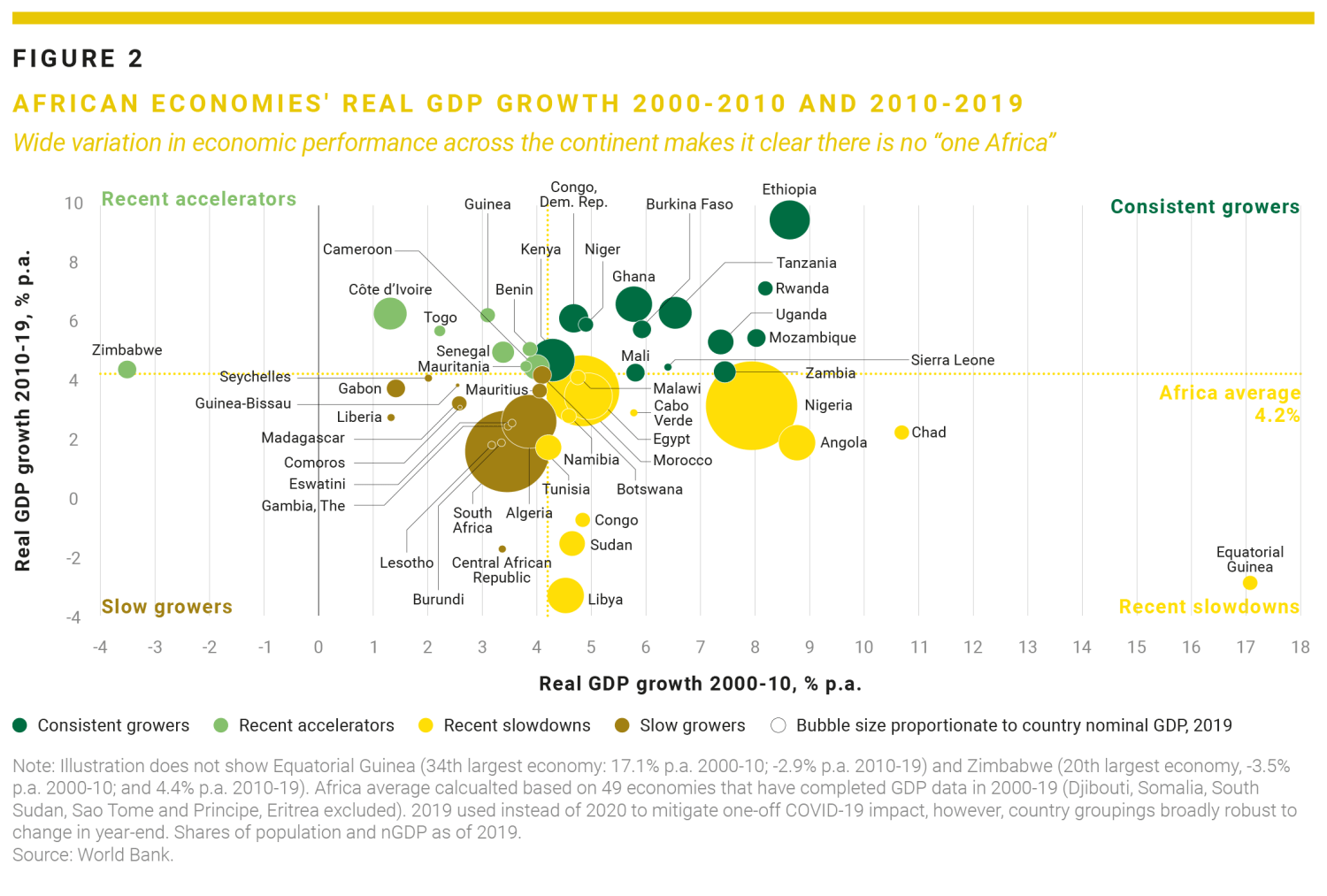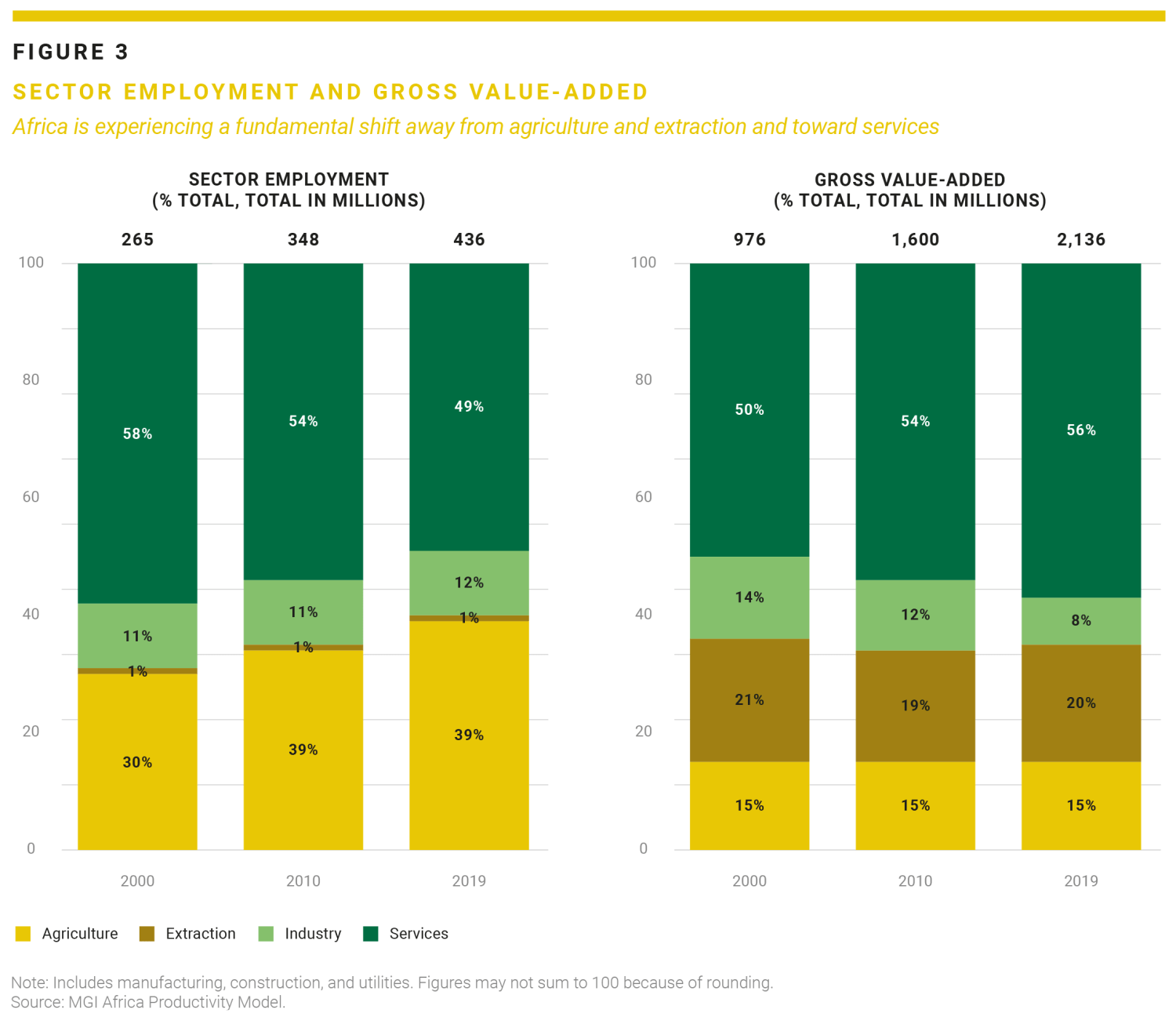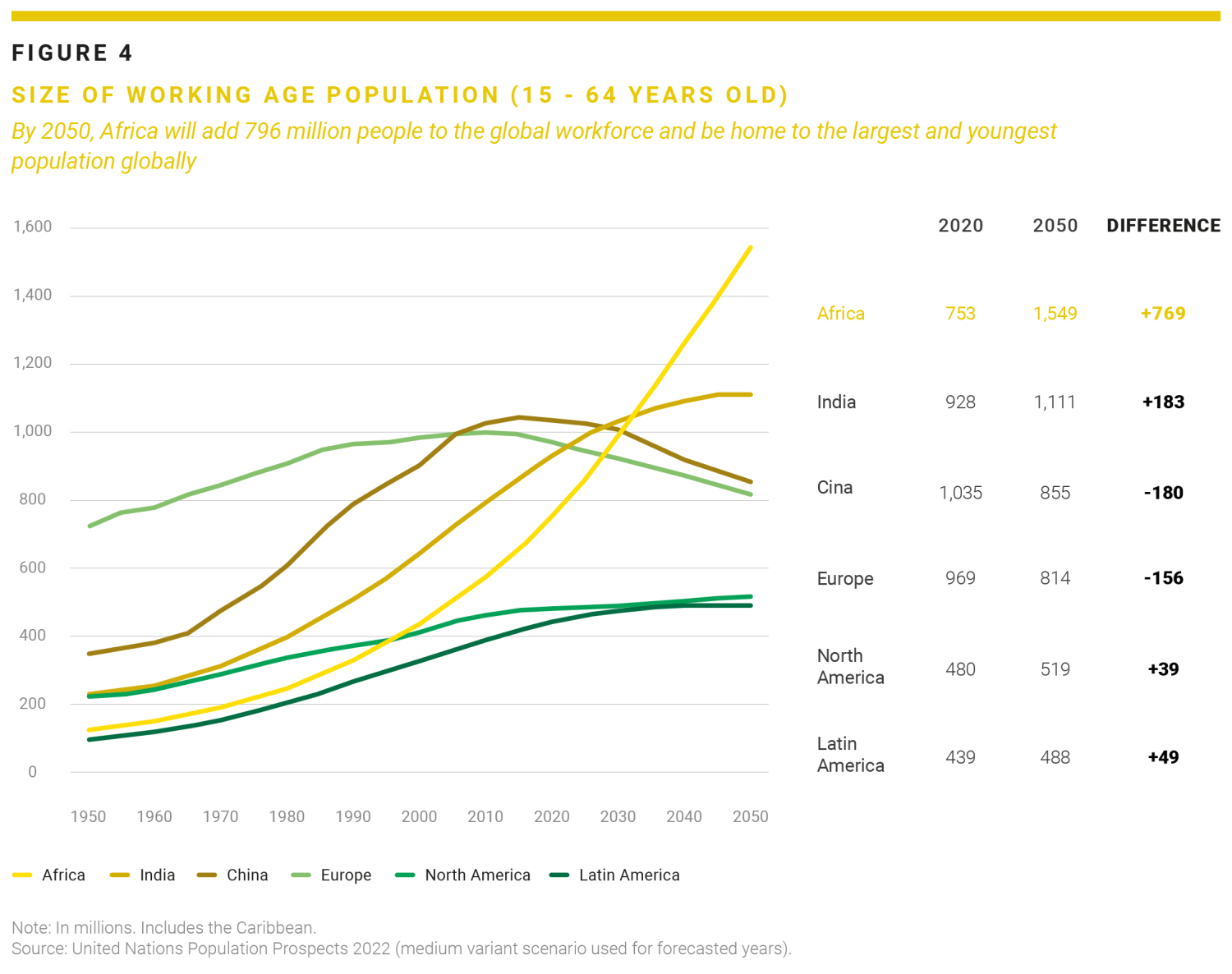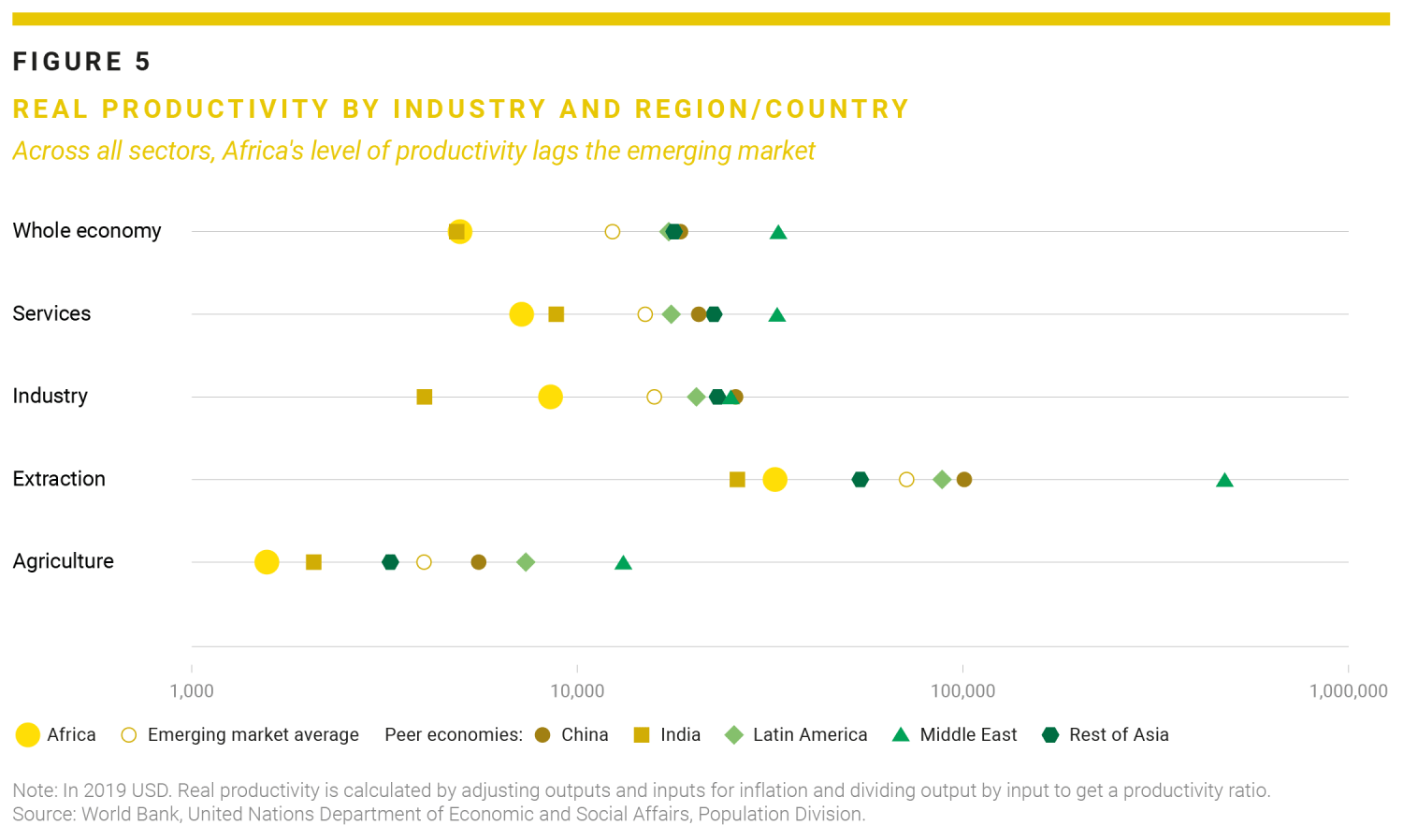Our Terms & Conditions | Our Privacy Policy
Leveraging Africa’s inner strength to realize its full economic potential
Editor’s note:
This essay opens Chapter 1 of Foresight Africa 2025-2030, which examines the urgent need for African nations to harness their internal strengths and reduce reliance on external forces to drive sustainable growth from within.
Africa is increasingly recognized as the next frontier for global economic growth.1 Its potential is vast, characterized by diverse natural resources, a burgeoning youth population, and untapped innovation. The question is no longer whether Africa will rise to meet the demands of a rapidly globalizing world, but how it will do so while building on its inherent strengths. It is home to the world’s youngest and fastest-growing population,2 fast-growing cities,3 and bold innovations in everything from fintech to clean energy. These present abundant opportunities for robust, inclusive growth that harnesses its vast human potential and natural resources to increase prosperity, not just in Africa but across the world.4
The question is no longer whether Africa will rise to meet the demands of a rapidly globalizing world, but how it will do so while building on its inherent strengths.
However, we approach these opportunities from a challenging starting point. Today, 60% of Africa’s population lives in poverty, the result of per capita income growth that has averaged just 1.1% a year for the past several decades (Figure 1).5 Unemployment of African youth sits at over 25% and more than 85% of Africans live with severe or moderate food insecurity.6 Low economic productivity across all sectors resulted in a 35% reduction in GDP growth over the last decade.7 Governance and the regional and national institutions at its foundations remain challenged across many parts of the continent. Investments in infrastructure and many critical social services (e.g., education and health) have fallen behind as fiscal headroom in many countries is under pressure.
It is important to note, however, that these continent-wide statistics obscure successes in many of its constituent countries that, while uneven, can serve as models to establish productivity as the foundation of Africa’s economic growth.8 Nearly half of Africa’s people live in countries where annual GDP growth between 2010 and 2019 exceeded 4.2%, the continent’s average growth rate since 2000.9 These countries were largely midsize economies and together accounted for just over one-quarter of total African GDP. They tend to be smaller, non-resource economies in east and west Africa (Figure 2).

The global context is also pertinent: Tepid global GDP growth of about 3.3% in 2023,10 increasing inflation, recovery from the impact of COVID-19, increased geopolitical volatility, impact of climate shocks, a rapidly aging global population and the potentially seismic impact of technology on the workforce all conspire to create opportunities and challenges for the African continent.
To realize its full economic potential, Africa must harness its diversity, leverage its strategic assets, and mitigate emerging challenges that come with globalization.11 Indeed, the continent is already in transition, for example Africa’s economies are shifting rapidly from agriculture and extraction to services. Reflecting that shift, employment in services increased from 30% to 39%.12 Services also secured its place as the major driver of the continent’s economic output, growing to 56% in the last decade compared with 50% in the 2000s as it captured shares from the extractive industries (Figure 3).13

Given this backdrop, we explore how Africa’s assets can position it for success in a globalized world, the lessons learned from successful initiatives, and key imperatives to set the continent on a path for success.
Africa’s unique strengths: A catalyst for growth
Africa’s strength lies in its diversity—geographically, economically, and culturally. Africa is not one monolith but a continent rich in varying resources, human capital, and economic capacities. The diversity of Africa’s economies, whether through its rich mineral wealth, dynamic agricultural landscapes, or the accelerating digital economies, positions the continent uniquely in the global marketplace. A few of these unique attributes are highlighted below:
1. Natural resources: Africa’s wealth in raw materials
Africa possesses approximately 30% of the world’s known mineral reserves such as gold, cobalt, and diamonds.14 Additionally, African-sourced materials are critical for transition to a low carbon economy—60% of the world’s production of manganese, about 70% of cobalt, and 70% of iridium occurs on the continent.15 Given the right infrastructure and trade policies, these resources can power industries both on the continent and globally.
The key to unlocking this potential lies in value addition. Historically, African nations have relied on exporting raw materials, but the future lies in creating local industries that can process and export finished goods. Countries such as Botswana have made strides by developing diamond-cutting and polishing industries rather than exporting rough stones.16 As the continent builds processing facilities and develops regional value chains, it can retain more wealth within the continent while creating jobs and raising living standards.
2. Human capital: Africa’s youth population
By 2050, Africa will account for at least one-quarter of the global workforce. With a median age of 19.7 years, Africa is home to the world’s youngest population.17 This young population can serve as both producers and consumers in the global economy, driving demand for goods and services while also forming a talent pool that the world would increasingly look to for innovation, entrepreneurship, and the digital economy. Given the changing global population growth dynamics, the imperative to make sure that our young population is educated and has the relevant skills is no longer an African one but a global one.

3. Digital economy: A growing tech hub
Africa is experiencing a technological revolution, with rapid growth in mobile device penetration, fintech, and e-commerce.18 The number of internet users for example, has grown by 17% annually since 2013.19 Mobile money services such as M-Pesa in Kenya have revolutionized financial services, allowing millions of Africans to participate in the formal economy. Africa’s tech startup scene, with the number of startups tripling in less than two years20—particularly in countries like Nigeria, Kenya, and South Africa—is gaining global attention and investment. By21 fostering innovation ecosystems and ensuring regulatory frameworks that support technology adoption, Africa can lead the digital economy in developing markets.
4. Urbanization and thriving cities
The future of Africa lies in its vibrant cities. Africa is the fastest-urbanizing place on earth, with more than 500 million people likely to leave the countryside between now and 2040.22 Most will move to the continent’s largest cities, increasing the need for better infrastructure to enable these migrants to thrive. Also by 2040, the number of cities with over 5 million inhabitants will grow from 12 to 31.23 Africa’s “second cities,” those with the second-largest population in each country, are generally much smaller than their largest counterpart. Among a set of the largest countries on the continent, only four of 14 have a second city larger than half the size of their primary city.24 Investment in these smaller second cities could take the pressure off their larger cousins, spreading rising productivity and incomes more broadly.
Challenges ahead: Navigating global and local dynamics
While Africa has immense potential, several challenges remain on the horizon.
1. Global economic volatility
Africa’s economies are highly vulnerable to external shocks, such as fluctuations in commodity prices, global recessions, and changes in trade and economic policies by major economies like the U.S. and China. For example, during the early phase of the pandemic, global demand plummeted, causing sharp declines in prices—particularly in oil, which dropped by more than 50%. This also occurred in the context where Africa’s volume share of the global commodity trade reduced by almost half, from 7% in 2010 to 4% in 2019.25 Global debt levels have reached historic highs, driven by pandemic-related government spending and borrowing. According to the IMF, global public debt rose to nearly 94% of global GDP in 2021.26 Rising interest rates in developed economies pose a significant challenge for countries with high levels of debt, particularly in Africa, where fiscal headroom is limited. Africa’s net external debt, while low by global standards, increased by 24% to 57% of GDP by 2019.27 Debt-servicing costs doubled, and current-account balances halved. Just three years later, in 2022, the region’s average debt-to-GDP ratio stood at 67%.28 Debt servicing has continued to hamstring governments in 2024 when it accounted for 13.6% of government expenditure across Africa.29 Building economic resilience through diversification and fostering domestic demand will be critical in mitigating these risks.
2. Increased political instability
Political instability also increased across the continent and continues to grow, even in countries with faster-growing economies. 30% of Africa’s population was affected by unstable political events such as coups that brought instability during the 2010s, compared with 4% in the 2000s.
3. Slowing economic growth and challenged productivity
Since 2010, Africa’s economic progress slowed due to a confluence of factors ranging from waning demand for commodities to deteriorating economic fundamentals in the continent’s largest economies. All these developments coincided with and contributed to a steep decline in Africa’s annual productivity growth, which fell from 2.2% in the 2000-10 decade to 0.8% in the last decade.30 Africa’s economy is now the least productive relative to emerging market peers today (Figure 5).

4. Climate change and environmental sustainability
Looking to the future, climate change may pose a new challenge to growth on the continent as Africa faces the potential for increasing weather-related acute events. By 2050, nearly 900 million people may face climate hazards.31 The transition to a global low-carbon economy could also impact Africa’s reliance on fossil fuel exports, which comprise 16% of its GDP. However, opportunities in green industries exist, and the continent must develop new businesses, secure investment, and build expertise to capitalize on the net-zero shift.
Charting a sustainable path: Fostering productive growth in Africa
Looking ahead, Africa’s economic growth must be driven by productivity. Africa’s rich diversity and growing population should be harnessed to build a productivity-focused economy, unlocking its full potential through innovation, value-added industries, and the development of human capital. This shift will ensure more resilient, sustainable growth that capitalizes on the continent’s internal strengths and capabilities. A few critical areas to consider include:
1. Investing to enhance resource productivity and tap into new opportunities
Extraction will be a part of the continent’s development going forward. Investment is therefore needed to raise the sector’s productivity. More broadly, as the world undertakes the energy transition, the types of natural resources it needs are changing, and Africa is well-positioned to become a significant supplier. Benefiting from both newly sought after and traditional resource exports is, however, not a given. Lessons learned from Africa’s historic reliance on extraction can be used to institutionalize best practices and strengthen governance to ensure that resource wealth is directed to minimizing the sector’s impact on the environment and spreading prosperity more broadly throughout African society. Investments in value addition will be crucial to maximize the continent’s benefits from its abundant natural resources.32
2. Leveraging digital innovation
To fully harness Africa’s economic potential, embracing digital technologies across all sectors is crucial.33 Digital innovations can enhance competitiveness, improve customer experiences, and increase productivity. Data analytics offer significant growth opportunities in Africa’s data-scarce environment. For governments, leveraging digital tools can boost efficiency, revenue collection, and service delivery. Additionally, developing a skilled African workforce tailored to local needs and global demands is vital. 230 million digital jobs could be created, of which over 10 million could be created through Tech and Business Process Outsourcing hubs.34 There are also enormous indirect job creation opportunities, including 650 million opportunities for digital training, translating into a $130 billion opportunity.35
3. Improving regional integration
Africa trades far more with other countries than with itself. In 2022, intraregional trade in Africa stood at only 14%,36 significantly lower than in other regions globally. Having more coordinated and aligned strategies across countries and regions, such as pharmaceutical manufacturing strategies that span entire African regions, can build resilience and improve productivity. The African Continental Free Trade Area (AfCFTA)37 presents an important opportunity, and its implementation should be accelerated by adapting established models such as the North American Free Trade Agreement, the European Union, the Association of Southeast Asian Nations, and others. Through the elimination of tariffs and the harmonization of standards, AfCFTA has the potential to transform Africa from a collection of small, fragmented markets into a cohesive, competitive region. Similarly, Africa can also better leverage its Regional Economic Communities (RECs) to support collaboration across national boundaries that will increase productivity and economic growth.
4. Exploring opportunities to benefit from the global net-zero agenda
While climate change poses challenges for Africa, the global transition to net-zero presents significant opportunities. Capturing these will require developing bankable projects, securing capital, and building technical expertise. African nations are also exploring their own net-zero pathways, aiming to expand energy access, reduce air pollution, and improve urban mobility while promoting economic growth. Eight green manufacturing opportunities have been identified that together could generate up to $2 billion in revenue a year in total and create 700,000 new jobs by 2030.38 However, challenges include the high initial costs of climate technologies and limited fiscal space. Large-scale support is essential to finance climate projects and protect vulnerable communities affected by the transition.
5. Harnessing the power of the African private sector
As of 2022, Africa had around 350 companies making over $1 billion in revenue. Of these, over 80% were from the private sector.39 Capitalizing on the strengths of these institutions will be essential to unlocking Africa’s productive potential. By mobilizing capital, fostering innovation, and building infrastructure, the private sector can drive economic growth across key industries while partnerships with governments can help develop capital markets and promote environments that attract long-term investments. Additionally, the private sector plays a pivotal role in creating jobs, training talent, and unlocking regional trade through supporting initiatives such as the AfCFTA.40 This collaboration can help Africa build a resilient, diversified economy that thrives in a global market.
Conclusion: Africa’s moment on the global stage
Africa stands at a pivotal moment in its economic journey. By leveraging its inherent strengths—natural resources, human capital, digital innovation, and regional integration—Africa can unlock its full potential. However, realizing this potential will require addressing the challenges of global economic volatility, climate change, and political instability. With the right policies in place, Africa can not only become a global economic player but also set a model for inclusive, sustainable growth in the 21st century.

The Brookings Institution is committed to quality, independence, and impact.
We are supported by a diverse array of funders. In line with our values and policies, each Brookings publication represents the sole views of its author(s).
Images are for reference only.Images and contents gathered automatic from google or 3rd party sources.All rights on the images and contents are with their legal original owners.



Comments are closed.